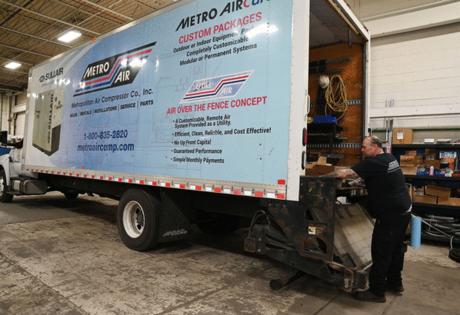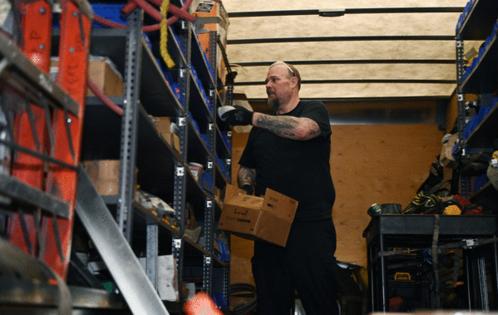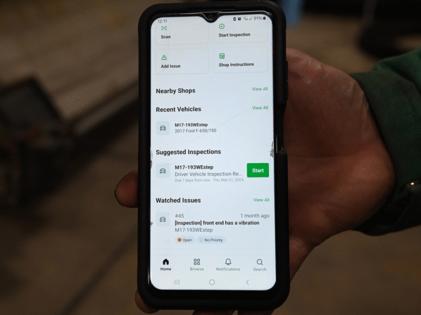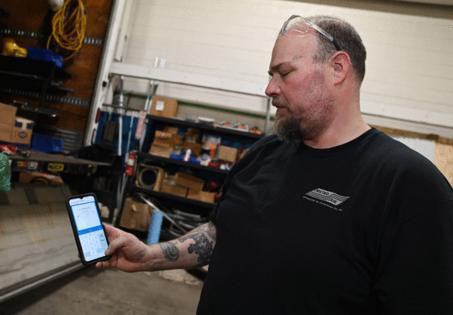Profit machine: Ford Pro commercial vehicle and tech business sets the automaker apart
Published in Automotive News
ROSEVILLE, Michigan — Ford Pro might just be Ford Motor Co.’s “Ferrari,” and some competitors say they are coming after it.
For years, the commercial vehicles segment was overlooked as less exciting, but connectivity is especially helping to change that picture. Today, Ford Pro is driving margins that are fueling the Blue Oval’s investment in its future, including electric vehicles. Meanwhile, major competitors are making changes they say will better serve their customers.
Ford Pro alone increased its operating income to $7.2 billion in 2023 by 81% with a 12.4% operating margin, even with a slower Super Duty truck production ramp-up with a new quality check process and a United Auto Workers strike. It's forecasting $8 billion to $9 billion in 2024 and a mid-teens margin. For scale, Ford Blue, the Dearborn automaker's internal combustion engine and hybrid vehicle business, posted an operating income of $7.46 billion and a 7.3% operating margin last year.
“I remember a time when Fiat owned Ferrari, and I had a valuation of about $4 billion on it,” said Adam Jonas, analyst at investment bank Morgan Stanley, while posing a question to Ford CEO Jim Farley during a recent earnings call. “Now, Ferrari is worth $80 billion today, and the business was totally ignored by investors when it was part of Fiat. Now, Ford's Ferrari, it's called Ford Pro. And I think we agree, people are ignoring the cash cow.”
Ford’s stock closed Friday at $12.06 per share, giving the company a market capitalization of $47.9 billion, according to Yahoo Finance. By comparison, Ferrari NV was valued at $77 billion on the Nasdaq. Meanwhile, General Motors Co. was nearly $47 billion, and Tesla Inc. was $520.9 billion.
Understanding the value of Ford Pro, the automaker's commercial vehicle unit, became clearer after the automaker last year began breaking out profits for its three divisions — Ford Blue, Ford Pro and Model e, its electric-vehicle division.
“How we've segmented the business is shining a light on the value of Ford Pro,” Tim Baughman, Ford Pro’s general manager, recently told The Detroit News. “In the past, the commercial side of the business wasn’t as understood. It may not be as exciting as the next Bronco or the next Mustang, or talking about it like, ‘It's just a commercial van.’”
Others are seeing the value in commercial, too. General Motors almost a year ago announced GM Envolve, a reimagining of GM Fleet as a “one-stop customer experience” for commercial business solutions across its brands, including the all-electric BrightDrop commercial van business. GM says it was the top seller of U.S. commercial fleet deliveries for a second consecutive year last year, with sales up 20% from 2022.
"The technologies that have changed the way consumers use their vehicles also impact the way fleet managers and owners use their vehicles for business needs, and our GM Envolve model was built through research and listening to fleet customers — from Fortune 500 companies on down to small mom-and-pop, local businesses," GM spokesperson Sabin Blake said in a statement. The model "gives GM Envolve customers one point of contact for the full suite of GM fleet products and services from hardware to software."
Earlier this month, Stellantis NV introduced Ram Professional as its commercial business division under the Stellantis Pro One commercial strategy focused on being a “360-degree” business partner. Its Dare Forward 2030 strategy calls for its commercial-vehicle business to represent half of the nearly $327 billion (300 billion euro) in annual revenues the automaker is projecting by 2030, including $5.4 billion (5 billion euro) in subscriptions.
A representative for Stellantis declined to comment, but Jeff Kommor, who recently assumed the new position of senior vice president of Ram Professional commercial sales, made the automaker's goal clear during the company’s press event last week at the National Truck and Equipment Work Truck Week in Indianapolis, according to Fleet Owner: “On March 1, they said, ‘Jeff, you have a new opportunity: Go and crush Ford Motor Company, and let’s become the No. 1 (light-commercial vehicle) machine on the planet.’ So that’s my goal. That’s my mission.”
With these new, aggressive pushes, it's shaping up to be a "war zone" in the sector, said Chris Frey, senior industry intelligence manager at auto information resource Cox Automotive Inc. "The next few years are probably going to be a little bit of a battlefield with respect to pricing, vehicle offerings and then customizations that the manufacturers can do themselves."
Ford says it holds a 40% U.S. market share of Class 1 through 7 full-sized trucks and vans.
“There's a lot of flattery,” Baughman said about the competitors, but “we’re not done. We are not done at all. We have a long roadmap of actions that are happening, and we plan to play.”
Ford Pro Chief Financial Officer Navin Kumar last month at a conference gave a glimpse at some of that future, and it includes video telematics, automatic control features and curated telematics data services.
Customers like Kevin Merritt have seen the rollout of new supports in real-time. His Metropolitan Air Compressor business based in Roseville began converting its fleet to Ford vehicles a decade ago when it introduced the Transit commercial van. He liked that his technicians didn’t need to hunch while working in the vans, and there was only one step into them instead of two, which makes it easier to carry equipment in and out of the vehicle. He has nearly 40 vehicles in his fleet, including Transits, F-series pickups and Super Duty trucks.
He said he’d requested mobile maintenance service that allows his technicians to be on their job site while getting an oil change, software updates, a filter replacement and other fixes. Ford Pro now offers that service through its dealerships with 1,200 vans and Super Duties.
“It reduces my downtime for my technicians,” Merritt said. “They’re still able to work while the vehicle is being worked on.”
Last year, Merritt began using Ford Pro Telematics after researching the options available. He liked that the plug-in device to leverage the software was designed specifically for the vehicles and that 2020 model-year vehicles and after have the module built into them.
The technology allows him to have an overall picture of his fleet, from each vehicle's maintenance to its location to its miles per gallon. His safety manager has direct access to daily vehicle safety checks and information on driving behavior. His chief financial officer can examine repair costs and identify when it makes sense to replace a vehicle. The company also receives a single bill at the end of the month for maintenance-related costs instead of having to reimburse employees. Technicians have access to information on the vehicles they drive on their phone, as well.
“I can’t put any dollar value on it,” Merritt said. “It’s one check a month versus multiple. It’s one spot to check everything. It saves time is what it saves. When you run out of time, you have to push things to the side. It makes running our business easier and more efficient.”
Metro Air is small enough that it doesn’t have a fleet manager. With the business’s permission, dealership Bill Brown Ford can assist in that by notifying the company when it sees that a vehicle needs maintenance or is under a recall.
“Every day that vehicle is down is critical,” said Jim Stevens, commercial vehicle manager at the Livonia dealership. “They're losing money, whether they're going to rent a vehicle, or they're just down a vehicle and just can't get the job done, or they lose a job. The benefits of telematics for us to help the customer is the amount of information that we can gather from it before the customer brings it into the dealership. We're set up to where we can access their telematics when they grant us those permissions to do that, and we can try to pinpoint the issues and try to get ahead of the problem and order the parts and be prepared.”
The dealership also offers mobile maintenance or can pick up the vehicle for service and deliver it back to the customer when done.
Ford has its own immediate strengths with F-series trucks being the best-selling vehicle in the United States for nearly half a century. CEO Farley said during a recent earnings call that order banks are exceeding the company’s supply of Ford Pro vehicles. Government infrastructure investments, the buildout of 5G telecommunication systems and the encouragement of domestic manufacturing are fueling built-tough sales. Farley said dealers normally get up to 75% of the volume they want for Ford Pro.
He noted Ford’s strengths among tradespeople and small businesses as well as long-term partnerships with upfitters. Growth opportunities, he said, are in software, service and aftersales.
Ford Pro has more than 500,000 software paid subscriptions, up 46% year-over-year, and the margins are more than 50%, according to the company. It’s expected this area will drive 20% of Ford Pro operating income in two years by getting to a 60% mix on connected vehicles and increasing its number of subscribers to a third from 12%.
"The magic is really connected services," Stephanie Brinley, principal automotive analyst for the Americas at S&P Global Inc., said, highlighting their thicker margins. For commercial customers, "it's about their business. They spend a little bit more if it makes sense for their business, but if it makes their vehicles run better, and if you’ve met value metrics for that customer, they'll stay, and they'll apply it to a greater number of vehicles."
Encouraging users to activate that option is a focus for growth, Baughman said. Customers have access to a complimentary "Essentials" program that has maintenance tracking, offers dealer scheduling and can remotely unlock or lock the vehicle. To upgrade to Ford Pro Telematics is $20 per month per vehicle, which adds fleet tracking, fuel efficiency analytics, location history, additional security features, an app for employees to communicate with a manager, in-vehicle coaching and more. There are additional options depending on customer needs, as well.
The division also is a space for electric vehicle learnings. There's a larger sales mix on the E-Transit to local and state governments and small businesses than the internal combustion engine model, CFO Kumar said. The company offers certain telematics features specifically to support EVs, too.
"When it comes to electric vehicles in Pro," he said, "we've seen areas where it's going better than expected, and the EVs are actually really effectively meeting the use cases."
The strengths of Ford Pro are a differentiator for the Blue Oval, said Daniel Ives, analyst at investment firm Wedbush Securities Inc.
"Everyone is trying to compare themselves to Tesla," Ives said. "It's Ford's answer to show this is not your grandfather's Ford. It shows some of the initiatives and next-generation technology that's coming to Ford. It's a stretch to say it's Ferrari-like, but they have a massive opportunity to get new customers into the Ford ecosystem."
©2024 www.detroitnews.com. Visit at detroitnews.com. Distributed by Tribune Content Agency, LLC.














Comments